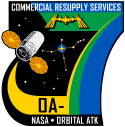Cygnus CRS OA-7
 | |
| Dane misji | |
| Indeks COSPAR | 2017-019A |
|---|---|
| Zaangażowani |
|
| Pojazd | |
| Statek kosmiczny | |
| Rakieta nośna | Atlas V 401 |
| Start | |
| Miejsce startu | |
| Początek misji | 18 kwietnia 2017 |
| Misja na Międzynarodową Stację Kosmiczną | |
| Lądowanie na ISS | Moduł Unity |
| Pobyt na ISS | 42 d 22 h 26 min |
| Lądowanie | |
| Miejsce lądowania | |
| Lądowanie | 11 czerwca 2017 |
| Czas trwania misji | 54 d 1 h 51 min |
| Commercial Resupply Services | |
Cygnus CRS OA-7 (inna nazwa Orbital Sciences CRS Flight 7) – misja statku transportowego Cygnus, prowadzona przez prywatną firmę Orbital ATK na zlecenie amerykańskiej agencji kosmicznej NASA w ramach programu Commercial Resupply Services w celu zaopatrzenia Międzynarodowej Stacji Kosmicznej. W misji uczestniczył statek nazwany S.S. John Glenn na cześć zmarłego astronauty Johna Glenna[1].
Przebieg misji
Start misji Cygnusa odbył się 18 kwietnia 2017 roku o 15:11 UTC[2]. Do wyniesienia statku na orbitę wykorzystana została rakieta Atlas V, która wystartowała z platformy startowej SLC-41 kosmodromu Cape Canaveral Space Force Station[3]. W misji wykorzystana została powiększona wersja statku Cygnus, która cechuje się pojemnością 27 m3 i możliwością wyniesienia na orbitę do 3,2 t ładunku[4].
22 kwietnia statek Cygnus zbliżył się do ISS, gdzie o 10:05 UTC został uchwycony przez Canadarm2 i przyciągnięty do portu cumowniczego modułu Unity, do którego zadokował o 12:39[5]. 4 czerwca 2017 o 11:05 UTC statek odłączono od stacji, a następnie odciągnięto przez Canadarm2 i wypuszczono o 13:10[6]. O 20:00 UTC przeprowadzono na pokładzie statku eksperyment SAFFIRE III, polegający na obserwacji spalania materiałów w warunkach mikrograwitacji[6]. 11 czerwca została przeprowadzona kontrolowana deorbitacja, w wyniku czego statek spłonął w atmosferze około 17:02 UTC[7].
Zobacz też
Przypisy
- ↑ Justin Ray, Next Cygnus commercial space freighter christened the S.S. John Glenn – Spaceflight Now [dostęp 2017-03-12].
- ↑ William Graham: Atlas V conducts OA-7 Cygnus launch to the ISS. [w:] NASASpaceFlight [on-line]. 2017-04-18. [dostęp 2017-04-18]. (ang.).
- ↑ Justin Ray, Atlas 5 rocket to launch space station cargo delivery mission in March, Spaceflight Now, 4 listopada 2016 [dostęp 2016-11-06] (ang.).
- ↑ Cygnus, Loty kosmiczne [dostęp 2017-06-03].
- ↑ Dwa orbitalne połączenia (22.04.2017), kosmonauta.net [dostęp 2017-04-23] (pol.).
- ↑ a b ISS crew bid early farewell to OA-7 Cygnus, the S.S. John Glenn | NASASpaceFlight.com, [w:] NASASpaceFlight [online] [dostęp 2017-06-09] (ang.).
- ↑ Chris Gebhardt: OA-7 Cygnus completes End of Mission; OA-8 looks to Sept launch. [w:] NASASpaceFlight [on-line]. 2017-06-11. [dostęp 2017-06-13]. (ang.).
Media użyte na tej stronie
The flag of Navassa Island is simply the United States flag. It does not have a "local" flag or "unofficial" flag; it is an uninhabited island. The version with a profile view was based on Flags of the World and as a fictional design has no status warranting a place on any Wiki. It was made up by a random person with no connection to the island, it has never flown on the island, and it has never received any sort of recognition or validation by any authority. The person quoted on that page has no authority to bestow a flag, "unofficial" or otherwise, on the island.
NASA insignia for Orbital ATK's OA-7 resupply flight
A crane lifts Orbital ATK's CYGNUS pressurized cargo module up and away from the KAMAG transporter inside the Payload Hazardous Servicing Facility at NASA's Kennedy Space Center in Florida. CYGNUS will be lowered onto a work stand for final propellant loading and late cargo stowage. The Orbital ATK CRS-7 commercial resupply services mission to the International Space Station is scheduled to launch atop a United Launch Alliance Atlas V rocket from Space Launch Complex 41 at Cape Canaveral Air Force Station on March 19, 2017. CYGNUS will deliver thousands of pounds of supplies, equipment and scientific research materials to the space station.
The Orbital ATK Cygnus pressurized cargo module is carried atop the United Launch Alliance Atlas V rocket from Space Launch Complex 41 at Cape Canaveral Air Force Station in Florida. Orbital ATK's seventh resupply services mission, CRS-7, will deliver 7,600 pounds of supplies, equipment and scientific research materials to the International Space Station. Liftoff was at 11:11 a.m. EDT.
The Cygnus resupply ship from Orbital ATK is remotely guided to its port on the Unity module by ground controllers using the Canadarm2 robotic arm.







